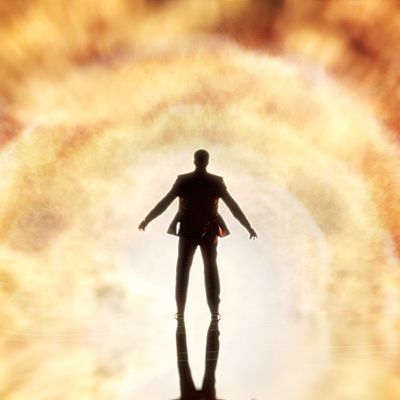
If you didnÔÇÖt already know that FoxÔÇÖs new Cosmos sequel is not like PBSÔÇÖs 1980 original, youÔÇÖd figure it out ┬¡during the pilotÔÇÖs long animated sequence about Giordano Bruno, a 16th-┬¡century ┬¡Italian Dominican friar who was imprisoned and then burned at the stake. ┬¡BrunoÔÇÖs crime was building on the theories of ┬¡Copernicus and positing an endless universe. We ┬¡understand what that imaginative leap cost him when Cosmos cuts away from the animation and pans across a tabletop filled with torture implements used on the friar. They look like woodworkerÔÇÖs tools. Cosmos spares us a demonstration of what they could do to flesh, but the point is still made: In the war to assure religionÔÇÖs pre┬¡eminence, heretics were shown no mercy.
The new Cosmos makes it clear that the war is still going on, and that this series is determined to be on the right side of it, by painting organized religion as an irrelevant and intellectually discredited means of understanding factual reality. This is a striking departure from the original ┬¡Cosmos, which debuted 11 years after the first astronauts walked on the moon, at a time when science and secular-humanist philosophy dominated American culture and thought. Co-┬¡scripted by the astrophysicist Carl Sagan, his wife, Ann Druyan, and ┬¡Steven Soter, the show was one of the great explanatory texts in TV history, mesmerizing for its then-┬¡sophisticated visual ┬¡effects, its New AgeÔÇôy synthesized score, and SaganÔÇÖs impassioned and poetic narration, which the host delivered in a much-┬¡imitated nasal baritone that made him seem like a guru of reason. Sagan was on record as being agnostic, but he carved out a space within the 1980 Cosmos for believers as well, and some of his more oracular turns of phrase (ÔÇ£The cosmos is all that is, ever was, or ever will beÔÇØ) convinced many people of faith that he was, if not an ally, then at least not an adversary.
This new Cosmos is not so easygoing. The post-1980s rise of the Evangelical right wing created a hostile environment for ┬¡science and science teachers. Recently, Louisi┬¡ana governor Bobby Jindal became the latest conservative politician to ominously warn of a war on religion, even as certain public-school districts allow the discussion of creationism to undermine evolution in classroomsÔÇöa development that would have been unthinkable 30 years ago. Bill Nye, the former host of Bill Nye, the Science Guy, recently took part in an evolution debate with Ken Ham, founder of Answers in Genesis, a group that believes in the literal truth of the Bible, including the part about the Earth being just six millennia old; the debate took place on HamÔÇÖs home turf, the Creation Museum in Petersburg, Kentucky. Climate change, which is endorsed to varying degrees by most legitimate scientists, is treated as a punch line by the Fox News Channel, a corporate sister of Fox, which is airing the new Cosmos in partnership with the still-┬¡science-┬¡driven ┬¡National Geographic Channel.
The new Cosmos feels like a pushback against faithÔÇÖs encroachments on the intellectual terrain of science. The show deploys blockbuster-quality visual effects, triumphant orchestral music by Alan Silvestri (who scored Robert ZemeckisÔÇÖs Contact, which is based on SaganÔÇÖs novel), and cartoon interludes rendered in the handmade style of a graphic novel to make the Big Bang, the rise of Copernican astronomy, and the basic principles of evolution seem as Hollywood-┬¡magnificent as the latest Marvel opus. But its greatest special effect is the laid-back charisma of its host, Neil deGrasse Tyson. Affable, plainspoken, and charming without seeming full of himself, Tyson might have seemed like SaganÔÇÖs obvious successor even if the master hadnÔÇÖt mentored him as a teen (a tale movingly recounted in the first episodeÔÇÖs final moments). He lacks SaganÔÇÖs Vulcan-like vibe but compensates with a self-┬¡deprecating average-guyness that often morphs, delightfully, into Danny Ocean cool. (ItÔÇÖs hard to imagine Sagan getting away with donning shades to watch the Big Bang, as Tyson does here.) The redesigned Ship of the Imagination evokes the flying saucer from Forbidden Planet; Tyson inhabits it as if it were, by turns, a lecture-hall stage, a deep-sea submersible, and a temple.
Tyson leads us through a primer on space and time that doubles as an advertisement for the scientific method. The narration is filled with what sound like digs at the ÔÇ£Science is kind of faith, too!ÔÇØ crowd. A tour of our solar system describes VenusÔÇÖs brutally stormy atmosphere as the by-product of a ÔÇ£runaway greenhouse effect.ÔÇØ The opening voice-over sums up Cosmos as the story of ÔÇ£how a band of hunter-┬¡gatherers found their way to the stars,ÔÇØ moving from GalileoÔÇÖs championing of heliocentrism to manned moon voyages in a matter of centuries. ÔÇ£Moses was born seven seconds ago,ÔÇØ Tyson narrates, as the show glides over moving pictograms representing the major faiths. ÔÇ£Buddha, six seconds ago. Jesus, five seconds ago. Muhammad, three seconds ago ÔǪ and it was only in the very last second of the cosmic calendar that we began to use science to reveal natureÔÇÖs secrets and her laws.ÔÇØ Every few minutes thereÔÇÖs a pointed reminder that while religion is great at uniting communities around shared values and expressing emotional truths, itÔÇÖs of zero use in determining the age of the planet. ÔÇ£Science gives us the power to see whatever our senses cannot,ÔÇØ Tyson says at one point; his tone suggests that, like most of CosmosÔÇÖ assertions, this one isnÔÇÖt open to debate. TysonÔÇÖs relaxed certitude syncs up with a phrase describing BrunoÔÇÖs championing of Copernican thought: ÔÇ£the gospel of infinity.ÔÇØ ThatÔÇÖs what Cosmos is spreading, too.
Cosmos: A Spacetime Odyssey, Fox, Sundays at 9 p.m.
*This article appeared in the February 24, 2014 issue of New York Magazine.


